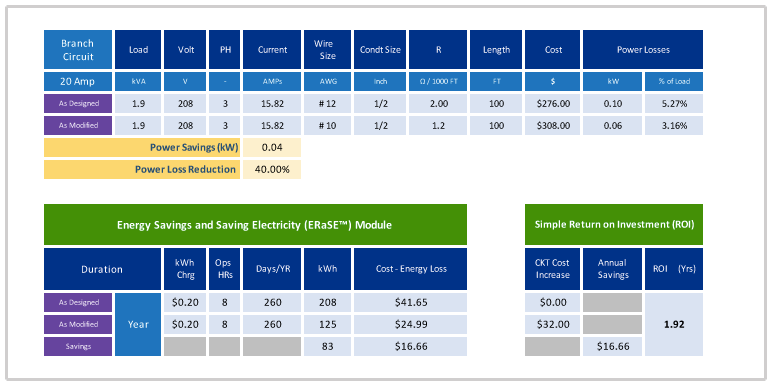
PowerCalc’s Energy Savings Module (ERASE™) saves 7% + of a building’s energy use by applying resistivity – a law of physics applicable to electrical power.
Simply, electricity is not hot, but conductors and wires transmitting electricity become hot indicating energy lost during distribution. This heat is generated by electrons and other atoms colliding in the material conducting the electrical current.
Provide more room for electrons to move (increase the conductor/wire size) and less heat is generated indicating less energy lost. PowerCalc calculates changes in the conductor/wire sizes and indicates Return-on–Investment (ROI) to determine the economics costs and benefits of increasing the conductor/wire sizes.
Significant savings are achieved by minimizing energy wasted through heat loss and maximizing energy saved.
Assume the following: L= 100 Ft., voltage 208Y/120, 8 hours of operation at $0.20 per kWh. Note: You can adjust both hours of operation and cost of kWh to suit your project.
Per the NEC, the design of a typical 20 amp circuit with 1.9 kVA load requires #12 AWG Branch Circuit Conductors installed in ½” conduit. Applying the engineering equation below, 4.22% of the energy delivered to the load will be dissipated per 100 Ft. of branch circuit conductor.
If the #12 AWG is modified to #10 AWG and installed in the same ½” conduit, then only 2.53% of the energy delivered to the load will be dissipated through the same 100 ft. of branch circuit conductor. This is a reduction in energy loss of approximately 40%. The Simple Return on Investment (ROI) is 1.92 years per the calculation below.
Energy Losses = I² x R
Where R is the conductor resistivity and I is the electrical current in amps.
Design of Circuit without using ERASE
Energy Losses = 0.100 kW
Modified Energy Losses with ERASE
Energy Losses = 0.06 kW
Comparison = 0.04 kW saved with ERASE
Annual Energy Loss Cost “as designed” = $41.62 per circuit
Annual Energy Loss Cost “modified” with ERASE = $24.97 per circuit
Annual savings modified with ERASE = $16.65 per circuit
The cost increase for #10 wire = $32.00 per circuit
Simple Return on Investment (ROI) = $32.00/$16.65 in 1.92 years
Just these simple steps and PowerCalc automatically generates a power distribution system that saves energy and reduces the facility’s carbon footprint.
Is this commercially viable? Return-on-Investment is at most 2 years for new construction and retrofits.
In new construction projects, resistivity is applied as part of the engineering process using PowerCalc’s integrated system to design the power distribution system in a building.
And in retrofits, the process is easier than you think. Just re-calculate the feeders and branch circuits, and then pull new conductors/wires in existing conduits. There are no expensive energy audits and no significant design time. Design time is reduced by at least 40%.
Note: It is unlikely that new conduits are necessary as the NEC requires that conductor/wire fill not exceed 40% of the conduit’s cross sectional area…and that is a lot of space. NEC Chapter 9 Table 1 “Percent of Cross Section of Conduit and Tubing for Conductors”. But to make certain there is no issue, PowerCalc calculates the conduit size needed and directs it to be increased as necessary.
Listed on US DOE’s Building Energy Software Tools Directory
PowerCalc is listed on the US Department of Energy’s Building Energy Software Tools Directory. See http://www.buildingenergysoftwaretools.com/software/powercalc
What’s this software list? The US DOE’s Office of Energy Efficiency and Renewable Energy lists software for “sustainable design, improving energy efficient, or incorporating renewable energy concepts in buildings.”
488 N. Federal Hwy, Boynton Beach, Florida 33435
(561) 278-9969
Inbound Performance Template by SmartBug Media. Copyright 2025.
All Rights Reserved
